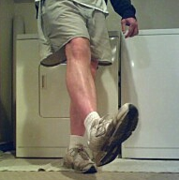PNF stretching
From Wikipedia, the free encyclopedia
| This article needs additional citations for verification. Please help improve this article by adding reliable references (ideally, using inline citations). Unsourced material may be challenged and removed. (May 2008) |
PNF (proprioceptive neuromuscular facilitation) stretching is a physical therapy procedure designed in the 1940s and 1950s to rehabilitate patients with paralysis.[1]
Stretching
It is often a combination of passive stretching and isometrics contractions. In the 1980s, components of PNF began to be used by sport therapists on healthy athletes. The most common PNF leg or arm positions encourage flexibility and coordination throughout the limb's entire range of motion. PNF is used to supplement daily stretching and is employed to make quick gains in range of motion to help athletes improve performance. Good range of motion makes better biomechanics, reduces fatigue and helps prevent overuse injuries. PNF is practiced by physical therapists, massage therapists, athletic trainers and others.[1]
Contents |
[edit] History
In the early to mid 1900s physiologist Charles Sherrington popularized a model for how the neuromuscular system operates. Irradiation is when maximal contraction of a muscle recruits the help of additional muscles. Reciprocal innervation causes one muscle to relax when its antagonist contracts, allowing a joint to bend. Successive induction is the contraction of one muscle followed immediately by the contraction of its antagonist, and this promotes strength and flexibility. Based on that, Herman Kabat, a neurophysiologist, began in 1946 to look for natural patterns of movement for rehabilitating the muscles of polio patients. He knew of the myostatic stretch reflex which causes a muscle to contract when lengthened too quickly, and of the inverse stretch reflex, which causes a muscle to relax when its tendon is pulled with too much force. He believed combinations of movement would be better than the traditional moving of one joint at a time. To find specific techniques, he started an institute in Washington, DC and by 1951 had two offices in California as well. His assistants Margaret Knott and Dorothy Voss in California applied PNF to all types of therapeutic exercise and began presenting the techniques in workshops in 1952. During the 1960s, the physical therapy departments of several universities began offering courses in PNF and by the late 1970s PNF stretching began to be used by athletes and other healthy people for more flexibility and range of motion. Terms about muscle contraction are commonly used when discussing PNF. Concentric isotonic contraction is when the muscle shortens, eccentric isotonic is when it lengthens even though resisting a force, and isometric is when it remains the same.[1]
[edit] Techniques
Hold Relax: most familiar. Also called Contract-Relax Involves the therapist asking the patient to fire the tight muscle isometrically against the therapist's hand for roughly 20 seconds. Then, the patient relaxes and the therapist lengthens the tight muscle and applies a stretch at the newly found end range. This technique utilizes the golgi tendon organ, which relaxes a muscle after a sustained contraction has been applied to it for longer than 6 seconds. Verbal cues for the patient performing this exercise would include, "Hold. Hold. Don't let me move you."
Contract-Relax with Antagonist Contract (CRAC): Also called Hold-Relax Contract. Same as Hold-Relax, patient isometrically contracts the tight muscle against the therapist's resistance. After a 20 second hold has been achieved, the therapist removes his/her hand and the patient concentrically contracts the antagonist muscle (the muscle opposite the tight muscle, the non-tight muscle) in order to gain increased range of motion. At the end of this new range, the therapist applies a static stretch before repeating the process again.
Hold-Relax-Swing/Hold-Relax Bounce: These are similar techniques to the Hold-Relax and CRAC. They start with a passive stretching by the therapist followed by an isometric contraction. The difference is that at the end, instead of an agonist muscle contraction or a passive stretching, involves the use of dynamic stretching and ballistic stretching. It is very risky, and is successfully used only by people that have managed to achieve a high level of control over their muscle stretch reflex.
Rhythmic Initiation: Developed to help patients with Parkinsonism overcome their rigidity. Begins with the therapist moving the patient through the desired movement using passive range of motion, followed by active-assistive, active, and finally active-resisted range of motion.
Rhythmic Stabilization: Also known as Alternating Isometrics, this technique encourages stability of the trunk, hip, and shoulder girdle. With this technique, the patient holds a position while the therapist applies manual resistance. No motion should occur from the patient. The patient should simply resist the therapist's movements. For example, the patient can be in a sitting, kneeling, half-kneeling, or standing position when the therapist applies manual resistance to the shoulders. Usually, the therapist applies simultaneous resistance to the anterior left shoulder and posterior right shoulder for 2-3 seconds before switching the resistance to the posterior left shoulder and the anterior right shoulder. The therapist's movements should be smooth, fluid, and continuous.
[edit] Gallery
[edit] See also
[edit] References
- The Truth About PNF Techniques: Proprioceptive neuromuscular rehabilitation is more than just stretching and functional movement. By James R. Scifers, DScPT, SCS, LAT, ATC. Advance for Physical Therapists and PT Assistants, December 6, 2004.
- Stretching and flexibility: Everything you never wanted to know by Brad Appleton.
See also:
- See: Pitt-Brooke, J. et al (1998) Rehabilitation of movement: theoretical basis of clinical practice (pp 382–94) London: Elsevier
- Adler, S. Beckers, D. Buck, M. (2007) PNF in Practice: An Illustrated Guide
(ISBN-10: 3540739017)











